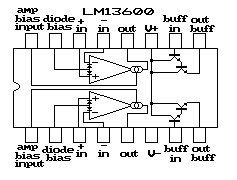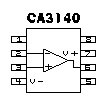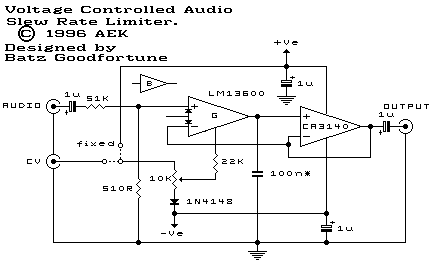Voltage Controlled Audio Slew Rate Limiter
The reason I've put this circuit here is as part of my quest for a circuit that
will come close to emulating that so called "Warm Valve Sound". Without using
the valves of course. Part of what I've heard in the valve sound has seemed a
lot like Slew rate limiting. It sounds like a low pass filter but isn't quite.
It sort of modifies the top end a little but not actually cuts it. Why would I
want to emulate that valve sound anyway? Why not use valves? Well you can't fit
32 12AX7s in a 1Unit 19 inch rack enclosure.
This circuit building block was based on the design published in the ETI Lab
Notes volume one book. On page 35. It has been adapted to accommodate an audio
signal and the CA3080 transconductance op amp has been replaced with one half
of an LM13600. This OTA is a little less noisy than the earlier 3080 but on the
whole it is very similar. The pin-out is shown bellow.

The 13600 has the addition of a pair of linearizing diodes that can be used to
improve signal handing. Since OTAs have a fairly wide open loop gain and
usually only like very small signals. If the linearizing diodes are required
some experimentation is required. The diode pins should be pulled up through a
suitable resistor. Not used in this circuit is the output buffer. This consists
of a darlington pair which is usually used as the high impedance buffer.
However in this case a CA3040 FET input op-amp is used. It is important that
the capacitor isn't loaded down. The pin-out diagram bellow for the CA3140
isn't exact. I don't have an exact reference for the part at this time. However
it is a standard 8 pin single op-amp package. There are probably pins for
offset adjustment etc but I don't know what they are.

The circuit is somewhere between a low pass filter and an integrator. A signal
at the output of the LM13600 will try to move towards the input voltage but
it's speed is limited by C1. Thus the output produces a linear ramp which stops
when it achieves the input voltage. The slew rate is given by. Slew rate =
Iabc/C1 as volts per second.

Since Iabc is variable, so to is the slew rate. You can either hook Iabc to the
positive supply rail or you can apply an external control voltage. This could
give rise to all sorts of modulation possibilities. More on that later.



